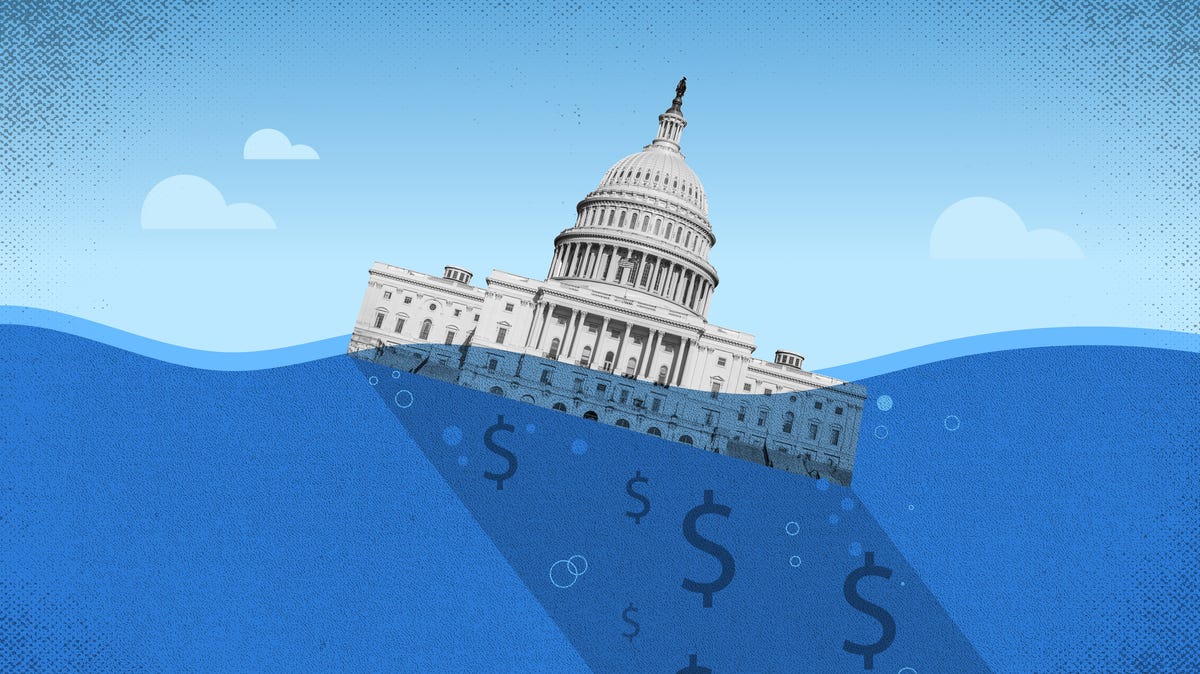The U.S. government’s gross national debt – the total amount of money owed its creditors and other financial obligations – hit a record high of more than $38 trillion on Oct. 22, the Treasury Department reported.
That translates to about $111,000 of debt per person in the United States, says the Peter G. Peterson Foundation, a think tank on fiscal policy.
The debt, which jumped $1 trillion in just 82 days from its previous record of $37 trillion on Aug. 2, is expected to keep rising, according to the Congressional Budget Office.
The CBO’s long-term outlook predicts the debt, “boosted by sustained deficits, will grow far beyond any previously recorded level over the next 30 years.”
You may think that’s simply a problem for Washington officials. However, the relentless increase in the national debt can affect you and your personal finances in terms of jobs, wages, loan costs and prices, says the Government Accountability Office.
National debt is expected to increase
Economists compare a country’s national debt to its gross domestic product as a way of showing its ability to pay down the debt, according to the Treasury Department.
The debt-to-GDP percentage gives a clearer picture of a country’s financial status than the dollar amount of the debt. That’s because it shows “the burden of debt relative to the country’s total economic output and therefore its ability to repay it,” Treasury says.
Generally speaking, higher percentages indicate a greater risk of national fiscal problems, including slower economic growth and increased borrowing costs, the GAO says.
How has the national debt increased since 2000?
In simple terms, the national debt can be compared to the federal government using a credit card, the Treasury says. When income is less than spending, the government borrows money, creating a deficit. That means the government must pay back the borrowed money and the interest on the borrowed amount.
What does the national debt cost the U.S. in interest?
As the debt increases, more interest money must be paid. Those interest payments have become large outlays in federal spending.
Interest payments on U.S. national debt have increased
The United States has recorded budget deficits – when government spending exceeds its revenue – every year since 2001, the Treasury says. Those deficits are part of the national debt, which keeps rising for several reasons, including:
◾Spending on mandatory programs, including Social Security, Medicare, and Medicaid, has increased, along with the nation’s aging population.
◾U.S. defense spending has risen significantly following the Sept. 11, 2001, terror attacks.
◾Economic crises caused by the 2008 financial crisis and the COVID-19 pandemic have resulted in trillions spent on stimulus packages and relief aid.
◾Failure of federal legislators to pass long-term budgets.
How does U.S. debt compare to other nations?What does this mean for you?
A high national debt could affect you in several ways, according to the GAO:
◾Higher interest rates for house mortgages, car loans and credit cards.
◾Stagnant wages with less business investment.
◾Higher-priced products owing to reduced investment in productivity.
◾Risk of inflation.
◾Possible cuts to domestic programs.
SOURCE USA TODAY Network reporting and research; Reuters; U.S. Treasury Department; Congressional Budget Office; Government Accountability Office; International Monetary Fund; World Bank; American Action Forum

